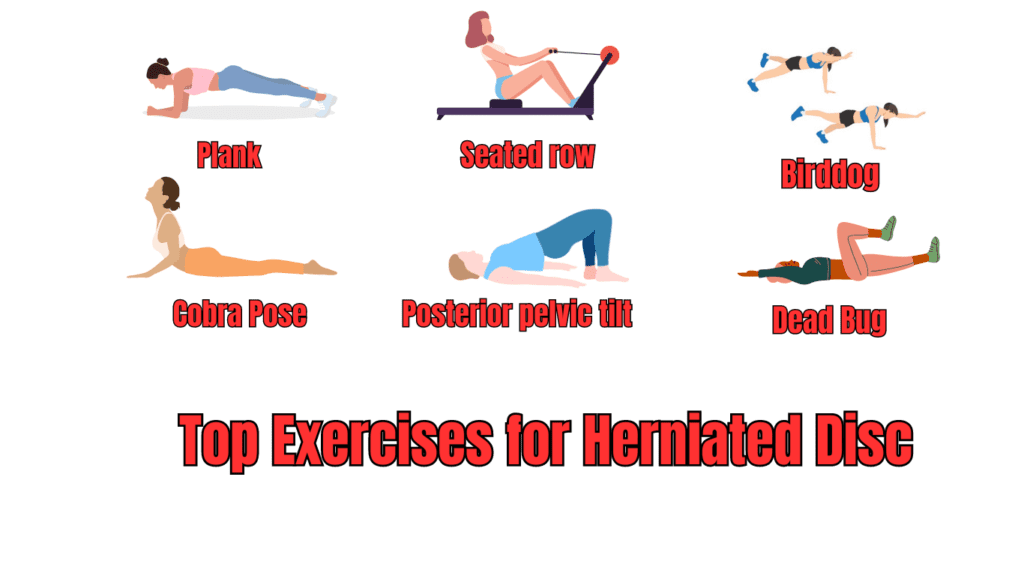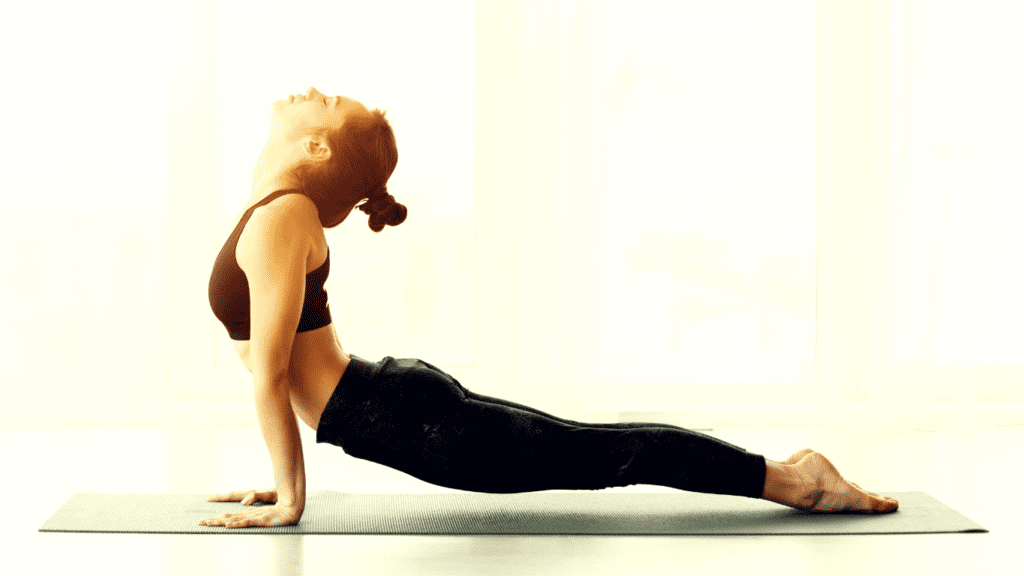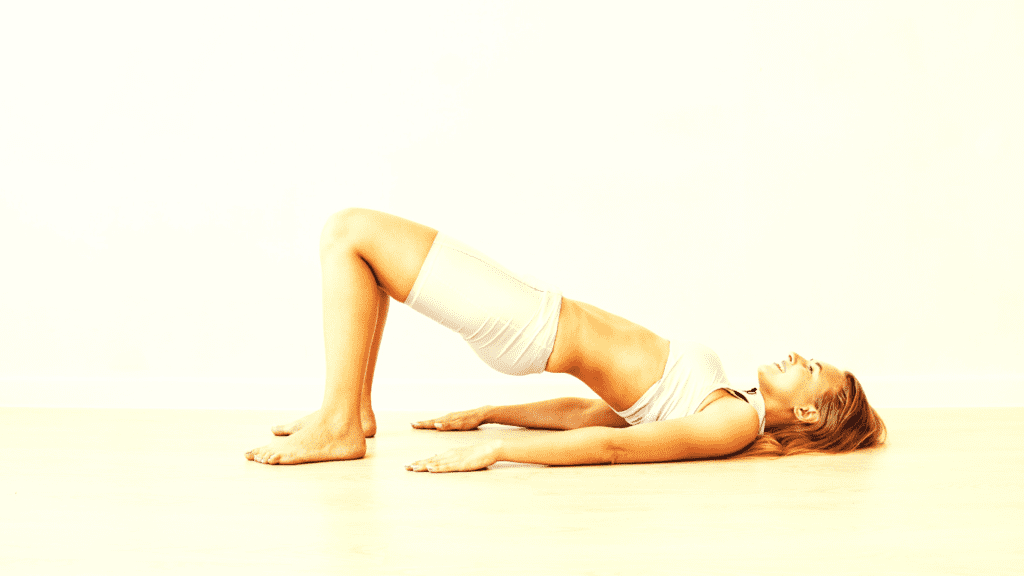Safe and Effective Full-Body Workout with Herniated Disc
In this article, we will explore safe ways to do a full-body workout with a herniated disc.
Living with a herniated disc can be a daunting challenge. It’s not just about dealing with the pain; it’s also about navigating through daily activities while being mindful of movements that could exacerbate the condition. But what exactly is a herniated disc? Essentially, it’s when one of the rubbery cushions (discs) between the individual bones (vertebrae) that stack up to make your spine gets damaged and bulges out. This can result in irritation of nearby nerves, leading to pain, numbness, or weakness in an arm or leg.
For those grappling with this condition, the thought of engaging in a full-body workout might seem counterintuitive or even risky. After all, won’t exercise exacerbate the pain and potentially cause further damage? While it’s crucial to approach exercise with caution, staying sedentary isn’t the solution either.
Exercise is a cornerstone of overall health, promoting cardiovascular health, muscle strength, flexibility, and mental well-being. However, for individuals with a herniated disc, traditional exercises like heavy lifting or high-impact activities can indeed be problematic. That’s where a tailored full-body workout with herniated disc comes into play—a workout designed to strengthen muscles, improve flexibility, and alleviate pain without exacerbating the condition.

In this article, we’ll delve into a safe and effective full-body workout with herniated disc. But before we dive into the specifics, it’s essential to emphasize the importance of consulting with a healthcare professional before embarking on any exercise regimen, especially if you have a pre-existing medical condition like a herniated disc. Your healthcare provider can provide personalized guidance based on your individual circumstances, ensuring that you engage in exercises that are safe and beneficial for you.
Now, let’s outline the primary goals of our full-body workout with herniated disc. Firstly, we aim to strengthen the muscles surrounding the spine, providing added support and stability. Secondly, we seek to improve flexibility and range of motion, reducing stiffness and discomfort. And finally, we endeavor to enhance overall fitness levels, promoting cardiovascular health and endurance.
Subscribe And Get Our Free E-Book:Unlocking The Power Of Nutrition-Supplements, Substitutes, and Superfoods!
Throughout this article, we’ll provide a variety of exercises targeting different muscle groups, ensuring a well-rounded full-body workout with herniated disc. Each exercise will be accompanied by modifications and considerations specific to individuals with a herniated disc, empowering you to exercise safely and effectively.
Remember, consistency is key when it comes to seeing results from your full-body workout. Start slowly, listen to your body, and gradually increase the intensity and duration of your workouts as your strength and confidence grow. With dedication and perseverance, you can reap the benefits of exercise while managing your herniated disc effectively. So let’s embark on this journey together, prioritizing our health and well-being every step of the way.
Understanding Herniated Discs
Understanding the intricacies of a herniated disc is paramount before delving into a full-body workout with herniated disc. Essentially, a herniated disc occurs when the soft inner core of a spinal disc protrudes through the tough outer layer, often due to wear and tear or sudden injury. This protrusion can irritate nearby nerves, leading to a myriad of symptoms including localized pain, numbness, tingling, and weakness in the affected area. While the lower back is the most common site for herniated discs, they can also occur in the neck.
Several factors can contribute to the development of a herniated disc. Age-related degeneration of the discs is a primary culprit, as the discs lose water content and elasticity over time, making them more susceptible to injury. Additionally, engaging in activities that involve repetitive lifting, twisting, or straining of the spine can increase the risk of herniation. Other risk factors include obesity, smoking, and genetics.
Given the potential complexities of managing a herniated disc, it’s crucial to seek guidance from a healthcare professional before embarking on any exercise regimen. A qualified healthcare provider, such as a physician or physical therapist, can conduct a thorough assessment of your condition and provide personalized recommendations tailored to your individual needs and limitations. This consultation is especially important when considering a full-body workout with herniated disc, as certain exercises may exacerbate symptoms if not performed correctly.

One common misconception surrounding exercise and herniated discs is the fear that physical activity will worsen the condition or cause further damage. While it’s true that certain exercises may need to be modified or avoided altogether, staying sedentary can actually worsen symptoms over time. In fact, engaging in regular, low-impact exercise can help strengthen the muscles surrounding the spine, improve flexibility, and alleviate pain associated with a herniated disc. The key is to approach exercise mindfully and with proper guidance from healthcare professionals.
Another fear that individuals with herniated discs may have is the uncertainty of which exercises are safe and effective for their condition. With the vast array of exercise options available, it’s understandable to feel overwhelmed and unsure of where to start. However, by working closely with healthcare professionals, you can develop a personalized full-body workout with herniated disc that addresses your specific needs and goals. This may involve a combination of stretching, strengthening, and cardiovascular exercises, tailored to your level of fitness and tolerance.
Ultimately, the decision to embark on a full-body workout with your condition should not be taken lightly, but neither should it be dismissed altogether. With proper guidance and a cautious approach, individuals with herniated discs can safely engage in exercise to improve their overall health and well-being. By consulting with healthcare professionals, addressing common misconceptions, and adopting a proactive mindset, you can take control of your condition and embrace the benefits of regular physical activity. So don’t let fear hold you back—take the first step towards a healthier, more active lifestyle today.
Benefits of Exercise for Herniated Discs
Engaging in a full-body workout isn’t just about breaking a sweat—it’s about taking proactive steps towards managing and potentially improving symptoms associated with this condition. While the idea of exercise may seem daunting, especially when dealing with pain and discomfort, the benefits it offers for individuals with herniated discs are undeniable.
One of the primary benefits of exercise for managing a herniated disc is its ability to strengthen the muscles surrounding the spine. When these muscles are weak or imbalanced, they provide inadequate support for the spinal column, leading to increased strain on the affected discs. By incorporating targeted exercises into your full-body workout with herniated disc, you can build strength in key muscle groups, such as the core, back, and hips, helping to stabilize the spine and reduce the risk of further injury.
Moreover, exercise plays a crucial role in improving flexibility and range of motion, which can be particularly beneficial for individuals with herniated discs. Tight or stiff muscles can exacerbate symptoms by placing additional stress on the spine and surrounding structures. By incorporating stretching and mobility exercises into your full-body workout with herniated disc, you can alleviate tension, reduce stiffness, and improve overall mobility, making everyday movements more comfortable and effortless.
Research has also shown that exercise can have a positive impact on pain management and functional outcomes for individuals with herniated discs. A study published in the Journal of Orthopaedic & Sports Physical Therapy found that a structured exercise program, including aerobic, strength, and flexibility exercises, resulted in significant improvements in pain intensity, disability, and quality of life in individuals with lumbar disc herniation. Another study published in the European Spine Journal concluded that supervised exercise therapy was effective in reducing pain and disability and improving functional capacity in patients with chronic low back pain, including those with herniated discs.

These findings underscore the importance of incorporating exercise into your management plan for a herniated disc. While it’s essential to approach exercise cautiously and seek guidance from healthcare professionals, the potential benefits far outweigh the risks. By committing to a regular full-body workout with herniated disc, you can take control of your symptoms, improve your quality of life, and regain confidence in your body’s ability to move and function effectively.
In addition to its physical benefits, exercise can also have a positive impact on mental well-being, which is often overlooked but equally important for individuals with herniated discs. Chronic pain and limited mobility can take a toll on mental health, leading to feelings of frustration, anxiety, and depression. Engaging in regular physical activity releases endorphins, chemicals in the brain that act as natural painkillers and mood elevators, helping to alleviate symptoms of stress and improve overall mood and outlook.
Incorporating mindfulness practices, such as deep breathing, meditation, or gentle yoga, into your full-body workout with herniated disc can further enhance the mental health benefits of exercise. These practices promote relaxation, reduce stress, and cultivate a greater sense of awareness and acceptance of your body’s limitations, empowering you to navigate the challenges of living with a herniated disc with greater ease and resilience.
Ultimately, the decision to embark on a full-body workout with your condition should be guided by your individual needs, preferences, and limitations. It’s essential to listen to your body, pace yourself, and modify exercises as needed to ensure safety and effectiveness. By incorporating a variety of exercises that target strength, flexibility, and cardiovascular fitness into your routine, you can maximize the benefits of exercise for managing your herniated disc and improving your overall health and well-being.
Key Considerations for Safe Full-Body Workout with Herniated Disc
Before diving into a full-body workout with herniated disc, it’s crucial to take stock of key considerations and precautions to ensure a safe and effective exercise experience. While exercise can offer numerous benefits for managing symptoms and improving overall well-being, it’s essential to approach it mindfully and with proper guidance. Here are some important factors to keep in mind before starting any exercise program with a herniated disc:

Chart: Common Exercises to Avoid and Safe Alternatives for Herniated Discs
| Common Exercises to Avoid | Potential Risk Factors | Safe Alternatives | Benefits of Safe Alternatives | Notes |
|---|---|---|---|---|
| Heavy Weightlifting | Excessive Spinal Compression | Bodyweight Exercises | Builds Strength, Minimizes Spinal Strain | Use caution with overhead movements |
| High-Impact Activities | Jarring Movements | Low-Impact Cardio | Improves Cardiovascular Health | Choose activities like cycling or swimming |
| Deep Squats | Increased Lumbar Pressure | Partial Squats | Targets Lower Body Muscles, Reduces Strain | Limit range of motion for safety |
| Running or Jogging | Repetitive Impact on Spine | Walking or Swimming | Low-Impact, Improves Endurance | Opt for brisk walks or water exercises |
| Crunches or Sit-Ups | Spinal Flexion | Pelvic Tilts or Planks | Core Strengthening, Spares Spine | Focus on core stability rather than flexion |
- Consult with a Healthcare Professional: Before embarking on any exercise regimen, it’s essential to consult with a healthcare professional, such as a physician or physical therapist, who can provide personalized guidance based on your individual circumstances. They can assess your condition, identify any potential limitations or contraindications, and recommend appropriate exercises tailored to your needs.
- Know Your Limitations: Listen to your body and be mindful of any pain or discomfort during exercise. While some degree of discomfort may be normal, especially when starting a new exercise program, sharp or shooting pain should be taken seriously and may indicate that you’re pushing yourself too hard. Adjust the intensity or modify the exercise as needed to avoid exacerbating symptoms.
- Avoid High-Impact Activities: Individuals with herniated discs should steer clear of high-impact activities that involve jarring or sudden movements, such as running, jumping, or heavy lifting. These activities can place excessive stress on the spine and increase the risk of further injury or aggravating symptoms. Instead, focus on low-impact exercises that are gentle on the joints, such as walking, swimming, or cycling.
- Emphasize Proper Form and Technique: Proper form and technique are paramount when exercising with a herniated disc to prevent further injury and maximize the effectiveness of your workouts. Pay close attention to your posture and alignment during each exercise, engaging the appropriate muscles and avoiding excessive strain on the spine. If you’re unsure about the correct form, consider working with a qualified fitness trainer or physical therapist who can provide guidance and feedback.
- Modify Exercises as Needed: Not all exercises are suitable for individuals with herniated discs, and some may need to be modified or avoided altogether. Be prepared to adapt your workout routine to accommodate your specific needs and limitations. For example, you may need to use props or modifications to support your spine during certain exercises, or opt for alternative exercises that target the same muscle groups without aggravating your symptoms.
- Gradually Increase Intensity: When starting a new exercise program, it’s important to start slowly and gradually increase the intensity and duration of your workouts over time. This allows your body to adapt and build strength without risking injury or overexertion. Pay attention to how your body responds to each workout and adjust accordingly to avoid pushing yourself too hard.
- Incorporate Variety: A full-body workout with herniated disc should include a variety of exercises that target different muscle groups and movement patterns. This not only prevents boredom but also helps prevent overuse injuries and ensures that all muscle groups are adequately strengthened and balanced. Mix and match exercises from various modalities, such as strength training, flexibility, and cardiovascular exercise, to keep your workouts engaging and effective.
- Listen to Your Body: Perhaps the most important consideration of all is to listen to your body and respect its signals. If something doesn’t feel right or if you experience any unusual symptoms during exercise, stop immediately and seek guidance from a healthcare professional. Pushing through pain or discomfort can lead to further injury and setbacks, so it’s important to prioritize your safety and well-being above all else.
Chart: Sample Full-Body Workout Routine for Herniated Discs
| Day | Workout Focus | Exercises | Sets x Reps | Notes |
|---|---|---|---|---|
| Monday | Upper Body Strength | Modified Push-Ups, Seated Dumbbell Presses | 3 x 10-12 | Use lighter weights to avoid strain |
| Tuesday | Cardiovascular | Brisk Walking, Stationary Cycling | 30-45 minutes of continuous activity | Choose low-impact options |
| Wednesday | Core Activation | Pelvic Tilts, Bird Dogs | 2 x 12-15 | Focus on proper form and alignment |
| Thursday | Lower Body Strength | Bodyweight Squats, Hip Bridges | 3 x 10-12 | Avoid deep squats or heavy weights |
| Friday | Flexibility and Mobility | Cat-Cow Stretches, Seated Spinal Twists | 2 x 30 seconds hold | Incorporate deep breathing |
By keeping these key considerations and precautions in mind, you can embark on a full-body workout with herniated disc with confidence, knowing that you’re taking proactive steps towards managing your condition and improving your overall health and well-being. With proper guidance, mindful movement, and a commitment to self-care, you can reap the benefits of exercise while minimizing the risk of exacerbating your symptoms.
Full-Body Workout Routine
Let’s dive into a comprehensive full-body workout with herniated disc specifically designed to strengthen muscles, improve flexibility, and alleviate pain without exacerbating the condition. This workout routine consists of a series of exercises targeting different muscle groups while minimizing strain on the spine. Each exercise will be accompanied by variations or modifications to accommodate different fitness levels and limitations, ensuring a safe and effective workout experience.

- Warm-up: Begin with a gentle warm-up to prepare your body for exercise. This could include five to ten minutes of light cardio, such as walking or cycling, followed by dynamic stretches to loosen up the muscles and joints.
- Core Activation: Engage the core muscles to provide stability and support for the spine. Perform exercises such as pelvic tilts, bird dogs, or abdominal bracing to activate the deep core muscles without placing excessive strain on the spine. Focus on maintaining proper form and alignment throughout.
- Upper Body Strength: Strengthen the muscles of the upper body, including the chest, shoulders, and arms, with exercises such as modified push-ups, seated dumbbell presses, or resistance band rows. Use lighter weights and focus on controlled movements to avoid aggravating the herniated disc.
- Lower Body Strength: Target the muscles of the lower body, including the glutes, hamstrings, and quadriceps, with exercises such as bodyweight squats, lunges, or hip bridges. Avoid deep squats or heavy weights that may place undue stress on the spine, and focus on maintaining a neutral spine alignment.
- Flexibility and Mobility: Improve flexibility and mobility in the spine and surrounding muscles with exercises such as cat-cow stretches, seated spinal twists, or foam rolling. These exercises help alleviate tension and reduce stiffness, promoting better range of motion and overall comfort.
- Cardiovascular Conditioning: Incorporate low-impact cardiovascular exercise to improve heart health and endurance without exacerbating symptoms. Options include brisk walking, cycling, or swimming, which provide a great cardiovascular workout without placing excessive stress on the spine.
- Cool-down and Stretching: Conclude your full-body workout with herniated disc with a thorough cool-down and stretching routine to help reduce muscle soreness and promote relaxation. Focus on stretching the major muscle groups worked during the workout, holding each stretch for 15-30 seconds and breathing deeply to enhance the stretch.
The Best Herniated Disc Exercises And Stretches Video
Now, let’s delve into the science behind each component of the workout and why it’s beneficial for individuals with a herniated disc:
- Core Activation: Strengthening the core muscles helps provide stability and support for the spine, reducing the risk of injury and improving overall posture and alignment. By activating the deep core muscles, such as the transverse abdominis and multifidus, you create a strong foundation for movement and reduce strain on the herniated disc.
- Upper Body Strength: Building strength in the upper body helps improve posture and reduce strain on the spine by supporting the weight of the upper body. Modified push-ups and seated dumbbell presses target the chest, shoulders, and arms without placing excessive stress on the spine, allowing you to safely build strength and endurance.
- Lower Body Strength: Strengthening the muscles of the lower body helps improve overall stability and balance, reducing the risk of falls and injury. Bodyweight squats, lunges, and hip bridges target the glutes, hamstrings, and quadriceps, which play a crucial role in supporting the spine and pelvis during movement.
- Flexibility and Mobility: Improving flexibility and mobility in the spine and surrounding muscles helps alleviate tension and reduce stiffness, promoting better range of motion and overall comfort. Cat-cow stretches, seated spinal twists, and foam rolling target tight muscles and connective tissue, helping to improve flexibility and reduce discomfort associated with a herniated disc.
- Cardiovascular Conditioning: Engaging in low-impact cardiovascular exercise helps improve heart health and endurance without exacerbating symptoms of a herniated disc. Brisk walking, cycling, and swimming provide a great cardiovascular workout while minimizing stress on the spine, allowing you to safely improve your cardiovascular fitness and overall health.
By incorporating these exercises into your full-body workout with herniated disc and understanding the science behind each component, you can take proactive steps towards managing your condition and improving your overall health and well-being. Remember to listen to your body, modify exercises as needed, and consult with a healthcare professional if you have any concerns or questions about your exercise routine. With dedication and consistency, you can reap the benefits of exercise while minimizing the risk of exacerbating your symptoms and enjoy a healthier, more active lifestyle.
Sample Workout Schedule
Let’s outline a sample full-body workout with herniated disc schedule to help you incorporate this exercise regimen into your routine effectively. Consistency is key when it comes to seeing results, but it’s equally important to allow for adequate rest and recovery to prevent overtraining and minimize the risk of injury.

Sample Workout Schedule:
Monday: Strength Training
- Begin the week with a focus on strength training exercises targeting different muscle groups. Perform exercises such as modified push-ups, bodyweight squats, seated dumbbell presses, and hip bridges. Aim for 3 sets of 10-12 repetitions for each exercise, with a 60-90 second rest between sets.
Tuesday: Cardiovascular Conditioning
- Engage in low-impact cardiovascular exercise to improve heart health and endurance. Options include brisk walking, cycling, or swimming. Aim for 30-45 minutes of continuous activity, maintaining a moderate intensity level throughout.
Wednesday: Rest or Active Recovery
- Take a day off from structured exercise to allow your body to rest and recover. Alternatively, engage in gentle activities such as walking, yoga, or stretching to promote circulation and mobility without placing undue stress on the spine.
Thursday: Flexibility and Mobility
- Focus on improving flexibility and mobility in the spine and surrounding muscles. Perform exercises such as cat-cow stretches, seated spinal twists, and foam rolling. Aim for 15-20 minutes of stretching and mobility work, focusing on deep breathing and relaxation.
Friday: Strength Training
- Return to strength training exercises to continue building muscle and strength. Incorporate exercises targeting the upper and lower body, such as modified push-ups, lunges, seated dumbbell presses, and hip bridges. Aim for 3 sets of 10-12 repetitions for each exercise, with a 60-90 second rest between sets.
Saturday: Cardiovascular Conditioning
- Engage in another session of low-impact cardiovascular exercise to further improve heart health and endurance. Choose an activity that you enjoy and can sustain for 30-45 minutes, whether it’s walking, cycling, or swimming.
Sunday: Rest or Active Recovery
- Take another day off from structured exercise to allow your body to fully rest and recover. Use this time to relax, engage in leisure activities, and focus on self-care practices such as meditation or deep breathing exercises.
Importance of Rest and Recovery:
Rest and recovery are essential components of any exercise program, especially for individuals with a herniated disc. Rest days allow your muscles to repair and rebuild stronger after intense workouts, reducing the risk of overuse injuries and burnout. Additionally, adequate rest helps regulate hormone levels, improve immune function, and promote overall well-being.
Incorporating rest and recovery days into your full-body workout with herniated disc schedule is crucial for preventing fatigue and ensuring long-term success. Listen to your body and pay attention to signs of overtraining, such as persistent fatigue, decreased performance, or increased susceptibility to illness. If you find yourself feeling excessively tired or sore, don’t hesitate to take an extra rest day or engage in light activity to promote recovery.
Remember, consistency is important, but so is balance. By following a structured workout schedule that includes regular rest and recovery days, you can safely and effectively manage your herniated disc while improving your overall fitness and quality of life. So stick to your schedule, listen to your body, and enjoy the journey towards a healthier, stronger you.
Tips for Success
As you embark on your journey with a full-body workout with herniated disc, it’s important to arm yourself with practical tips and strategies to ensure success and maximize the benefits of your exercise regimen. By incorporating these tips into your routine, you can overcome challenges, stay motivated, and achieve your fitness goals while managing your herniated disc effectively.
Gradually Increase Intensity: When starting a new exercise program or increasing the intensity of your workouts, it’s crucial to do so gradually to allow your body to adapt and minimize the risk of injury. Start with low-impact exercises and lighter weights, gradually increasing the intensity as your strength and endurance improve. Listen to your body and pay attention to any signs of discomfort or fatigue, adjusting the intensity as needed to ensure safety and effectiveness.
Stay Consistent: Consistency is key when it comes to seeing results from your full-body workout with herniated disc. Aim to exercise regularly, sticking to your workout schedule even on days when you may not feel motivated. Remember that progress takes time, and staying consistent with your workouts will yield long-term benefits for your health and well-being.
Listen to Your Body: One of the most important things you can do when exercising with a herniated disc is to listen to your body. Pay attention to how your body feels during and after exercise, and adjust your workout accordingly. If you experience any pain or discomfort, stop immediately and reassess your form or modify the exercise to alleviate strain on the spine. Remember that pushing through pain can lead to further injury, so always prioritize safety and listen to your body’s signals.

Track Your Progress: Keeping track of your progress can help you stay motivated and accountable, providing tangible evidence of your hard work and dedication. Keep a workout journal or use a fitness tracking app to record your workouts, including the exercises performed, sets and repetitions, and any modifications made. Tracking your progress allows you to see how far you’ve come and identify areas for improvement, empowering you to adjust your workout routine as needed to continue making progress towards your goals.
Adjust Your Workout Routine: As you progress in your fitness journey, it’s important to periodically reassess your workout routine and make adjustments as needed. This may involve increasing the intensity of your workouts, adding new exercises to target different muscle groups, or incorporating new challenges such as interval training or circuit workouts. By keeping your workouts varied and challenging, you can continue to challenge your body and prevent plateaus in your progress.
Stay Positive and Patient: Finally, it’s important to maintain a positive attitude and be patient with yourself as you work towards your fitness goals. Living with a herniated disc can present unique challenges, but with dedication, perseverance, and a positive mindset, you can overcome obstacles and achieve success. Celebrate your achievements, no matter how small, and focus on the progress you’re making each day. Remember that Rome wasn’t built in a day, and with time and effort, you can achieve the results you desire.
By incorporating these practical tips and strategies into your full-body workout with herniated disc, you can set yourself up for success and make the most of your exercise regimen. Remember to prioritize safety, listen to your body, and stay consistent with your workouts. With dedication and perseverance, you can overcome obstacles, achieve your fitness goals, and enjoy the many benefits of regular exercise while managing your herniated disc effectively. So lace up those sneakers, embrace the challenge, and get ready to take your fitness journey to new heights.
Managing Herniated Discs: The Importance of Exercise
In conclusion, a full-body workout with herniated disc can be a safe and effective way to manage symptoms, improve overall health, and enhance quality of life. Throughout this article, we’ve explored the importance of exercise for individuals with a herniated disc, discussing its benefits for strengthening muscles, improving flexibility, and alleviating pain. We’ve outlined key considerations and precautions to take before starting an exercise program, emphasizing the importance of consulting with a healthcare professional and listening to your body to ensure safety and effectiveness.
Furthermore, we’ve provided a comprehensive full-body workout with herniated disc routine tailored specifically for individuals with this condition, incorporating exercises that target different muscle groups while minimizing strain on the spine. By gradually increasing intensity, staying consistent, and listening to your body, you can make progress towards your fitness goals while managing your herniated disc effectively.
It’s important to remember that progress takes time and patience, and setbacks may occur along the way. However, by staying positive and committed to your fitness journey, you can overcome obstacles and achieve success. Remember to track your progress, adjust your workout routine as needed, and celebrate your achievements, no matter how small.
Above all, remember that you’re not alone in your journey. Reach out to healthcare professionals, fitness trainers, or support groups for guidance, encouragement, and support. Surround yourself with positivity and embrace the challenge of improving your health and well-being despite your condition.
So, if you’re ready to take control of your health and embark on your fitness journey, don’t hesitate to start incorporating the provided full-body workout with herniated disc routine into your lifestyle today. With dedication, perseverance, and a positive mindset, you can overcome obstacles, achieve your fitness goals, and enjoy a healthier, more active lifestyle. You’ve got this!


